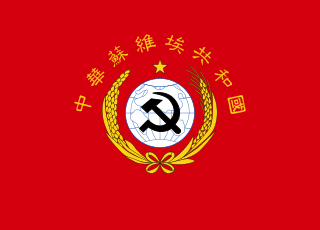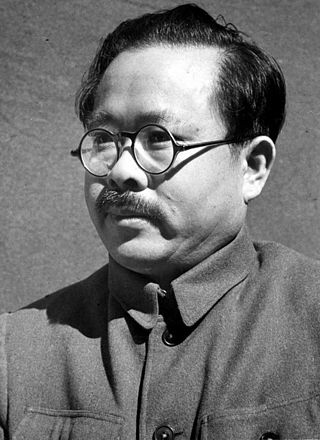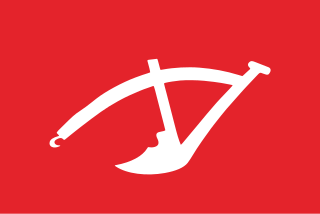
The Long March was a military retreat by the Chinese Red Army from advancing Nationalist forces during the Chinese Civil War in 1934 through 1936.

Peng Dehuai was a Marshal of the People's Republic of China, and the country's Minister of National Defense from 1954 to 1959. Peng was born into a poor peasant family, and received several years of primary education before his family's poverty forced him to suspend his education at the age of ten, and to work for several years as a manual laborer. When he was sixteen, Peng became a professional soldier. Over the next ten years Peng served in the armies of several Hunan-based warlord armies, raising himself from the rank of private second class to major. In 1926, Peng's forces joined the Kuomintang, and Peng was first introduced to communism. Peng participated in the Northern Expedition, and supported Wang Jingwei's attempt to form a left-leaning Kuomintang government based in Wuhan. After Wang was defeated, Peng briefly rejoined Chiang Kai-shek's forces before joining the Chinese Communist Party (CCP), allying himself with Mao Zedong and Zhu De.

The Chinese Soviet Republic (CSR) was a state within China, proclaimed on 7 November 1931 by Chinese Communist Party (CCP) leaders Mao Zedong and Zhu De in the early stages of the Chinese Civil War. The discontiguous territories of the CSR included 18 provinces and 4 counties under the communists' control. The CSR's government was located in its largest component territory, the Jiangxi Soviet. Due to the importance of the Jiangxi Soviet in the CSR's early history, the name "Jiangxi Soviet" is sometimes used to refer to the CSR as a whole. Other component territories of the CSR included the Northeastern Jiangxi, Hunan-Jiangxi, Hunan-Hubei-Jiangxi, Hunan-Western Hubei, Hunan-Hubei-Sichuan-Guizhou, Eyuwan, Shaanxi-Gansu, Sichuan-Shanxi, and Haifeng-Lufeng Soviets.

The Jinggang Mountains, historically rendered as Chingkang Mountains are a mountain range of the Luoxiao Mountains System, in the border region of Jiangxi and Hunan Provinces.

The Nanchang Uprising was the first major Nationalist Party of China–Chinese Communist Party engagement of the Chinese Civil War, begun by the Chinese Communists to counter the Shanghai massacre of 1927 by the Kuomintang.

Yuan Wencai, also Yuan Xuansan was a former bandit chieftain who operated in the Jinggang Mountains of Jiangxi, from 1923, and then joined the Chinese Communist Party, becoming a protégé of Mao Zedong during their formative period in the Jiangxi Soviet. However, it cost his own life in the following power struggle within the Chinese Communist Party.
Wang Zuo, also Wang Yunhui (王雲輝) or Wang Yunfei (王雲飛), nicknamed Nandougu (南斗牯), was a former bandit chieftain who operated in the Jinggang Mountains of Jiangxi, from 1923, and then joined the Chinese Communist Party, becoming a protégé of Mao Zedong during their formative period in the Jiangxi Soviet. However, this cost him his own life in the following power struggle within the Communist Party of China.

He Long was a Chinese Communist revolutionary and a Marshal of the People's Republic of China. He was from a poor rural family in Hunan, and his family was not able to provide him with any formal education. He began his revolutionary career after avenging the death of his uncle, when he fled to become an outlaw and attracted a small personal army around him. Later his forces joined the Kuomintang, and he participated in the Northern Expedition.
The history of the People's Liberation Army began in 1927 with the start of the Chinese Civil War and spans to the present, having developed from a peasant guerrilla force into the largest armed force in the world.

The Shanghai massacre of 12 April 1927, the April 12 Purge or the April 12 Incident as it is commonly known in China, was the violent suppression of Chinese Communist Party (CCP) organizations and leftist elements in Shanghai by forces supporting General Chiang Kai-shek and conservative factions in the Kuomintang. Following the incident, conservative KMT elements carried out a full-scale purge of communists in all areas under their control, and violent suppression occurred in Guangzhou and Changsha. The purge led to an open split between left-wing and right-wing factions in the KMT, with Chiang Kai-shek establishing himself as the leader of the right-wing faction based in Nanjing, in opposition to the original left-wing KMT government based in Wuhan, which was led by Wang Jingwei. By 15 July 1927, the Wuhan regime had expelled the Communists in its ranks, effectively ending the First United Front, a working alliance of both the KMT and CCP under the tutelage of Comintern agents. For the rest of 1927, the CCP would fight to regain power, beginning the Autumn Harvest Uprising. With the failure and the crushing of the Guangzhou Uprising at Guangzhou however, the power of the Communists was largely diminished, unable to launch another major urban offensive.
The Little Long March was a 600-kilometre (370 mi), two-month withdrawal by left-wing members of the Kuomintang and the National Revolutionary Army up the Gan River and down to the coast, subsequent to the successful mutiny and insurrection at Nanchang on August 1, 1927.

Ren Bishi was a military and political leader in the early Chinese Communist Party (CCP).

The Chinese Communist Revolution was a social and political revolution that culminated in the establishment of the People's Republic of China (PRC) in 1949. For the preceding century, China had faced escalating social, economic, and political problems as a result of Western imperialism, Japanese imperialism, and the decline of the Qing dynasty. Cyclical famines and an oppressive landlord system kept the large mass of rural peasantry poor and politically disenfranchised. The Chinese Communist Party (CCP) was formed in 1921 by young urban intellectuals inspired by European socialist ideas and the success of the October Revolution in Russia. The CCP originally allied itself with the nationalist Kuomintang (KMT) party against the warlords and foreign imperialist forces, but the 1927 massacre of Communists in Shanghai ordered by Kuomintang leader Chiang Kai-shek forced them into the Chinese Civil War, which would last more than two decades.

The Chinese Red Army, formally the Chinese Workers' and Peasants' Red Army or just the Red Army, was the military wing of the Chinese Communist Party from 1928 to 1937. It was formed when Communist elements of the National Revolutionary Army splintered and mutinied in the Nanchang Uprising. The Red Army was reincorporated into the National Revolutionary Army as part of the Second United Front with the Kuomintang to fight against the Japanese during the Second Sino-Japanese War of 1937–1945. In the later stages of the Chinese Civil War they splintered off once again and renamed the People's Liberation Army.

The Baise Uprising was a short-lived uprising organized by the Chinese Communist Party (CCP) in northwestern Guangxi around the city of Baise. It officially began on December 11, 1929, and lasted until late 1931. The uprising established the Seventh Red Army and a soviet over a number of counties in the You River valley. It drew support from a pre-existing movement of Zhuang peasants led by Wei Baqun, and focused on land redistribution in the area it controlled. After a brief but costly attempt to capture Guangxi's major cities, the soviet was suppressed and surviving soldiers made their way to Jiangxi. Today, it is most famous for the role played by Deng Xiaoping, who was the CCP Central Committee's leading representative in Guangxi during the Uprising. Deng was strongly criticized, both during the Cultural Revolution and by modern historians, for the uprising's swift defeat and his decision to abandon the retreating Seventh Red Army.
The Site of Joining Forces in Wenjiashi of Autumn Harvest Uprising is located in Wenjiashi Town, approximately 51km from Liuyang city, Hunan, China. It contains buildings such as Liren School and the Memorial Museum. It is one of the most popular tourist attractions in Liuyang, Hunan province.
Li Zhen was the first female general of the People's Liberation Army.

The Chinese National Peasants' Association, otherwise known as the Chinese Peasants' Association, was a peasant organization created in 1927 with the specific aim of transforming the peasantry via Socialism. It was led by the Chinese Communist Party until its dissolution in 1964. Its successor was the Chinese National Poor and Lower-Middle Peasants' Association, created in 1964 and dissolved de facto in 1986.

Report on an Investigation of the Peasant Movement in Hunan or Inquiry into the Peasant Movement of Hunan of March 1927, often called the Hunan Report, is one of Mao Zedong's most famous and influential essays. The Report is based on a several month visit to his home countryside around Changsha, capital of Hunan in early 1927. The Report endorses the violence that had broken out spontaneously in the wake of the Northern Expedition, makes a class analysis of the struggle, and enthusiastically reports the "Fourteen Great Achievements" of the peasant associations (农民协会).
The following is a topical outline of English Wikipedia articles about the history of the Chinese Civil War (1912–1949)














